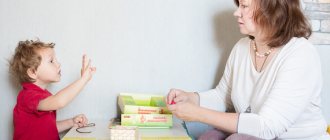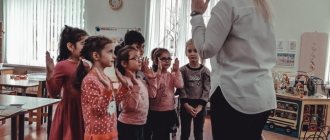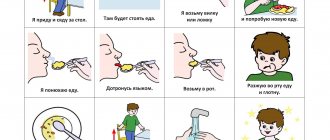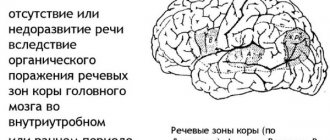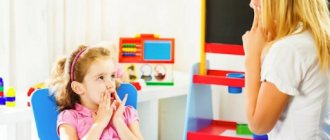Annotation:
The material presented in the methodological recommendations “Initial stages of correctional and developmental work with speechless children” will help speech therapists and parents in the formation of speech through a coordinated impact on non-speech functions in the process of leading activities.
This article describes in detail: a polymorphic group of children with an inability to use the means of language. In compensatory preschool educational institutions, children included in this group may have speech development delays (up to 4 years), general speech underdevelopment, and alalia. The characteristics of children with this speech pathology develop under conditions of dysontogenesis.
The main stages of work, taking into account the level of development at which the child is at the beginning of education.
The implementation of this material can be included in the pedagogical process: in classes of the cognitive cycle, games, work, free activity, entertainment, leisure.
Speechless children are a conventionally identified polymorphic group of children with an inability to use language. In compensatory preschool educational institutions, children included in this group may have speech development delays (up to 4 years), general speech underdevelopment, and alalia. The basis for their combination is the following provisions:
1. Children with this speech pathology develop under conditions of dysontogenesis.
Ontogenesis is understood as the individual development of an organism, which is especially intense before reaching puberty. The term “dysontogenesis” refers to deviations of prenatal (intrauterine), natal (during childbirth) formation of body structures from normal development, which can actively develop in postnatal ontogenesis, mainly early, when the morphological systems of the body have not reached maturity. (The development of a child occurs on a defective basis. When brain cells are damaged, immature, inactivated, the processes of neurodynamics - cell maturation - are disrupted).
The development of a child in conditions of dysontogenesis determines the presence of stable neurological symptoms in the form of minimal cerebral cerebral dysfunction (MCD or MMCD), which is a long-term consequence of “perinatal encephalopathy” (the diagnosis of “perinatal encephalopathy” is made only in the first year of a child’s life) and is manifested by increased excitability, emotional instability, impaired perception, diffuse and mild focal neurological symptoms. Motor development is not severely affected, but a kind of motor clumsiness and erased motor disturbances are revealed. In children with a history of minimal cerebral dysfunction, you will find scattered neurological symptoms: asymmetry of facial innervation, there may be the presence of slight spasticity, valgus or vargus position of the feet, scoliosis, strabismus, a slight decrease in visual acuity, signs of partial motor immaturity (tremor manifested during exercise, excitement), a lag in the formation of general dynamic praxis. In the mental state of these children, certain features of general emotional-volitional immaturity, insufficiency of active attention functions, fatigue or increased excitability are noted. The pathogenetic basis of this condition is the delayed maturation of late-forming brain structures and functions.
In psychoorganic syndrome, the neurological and psychological disorders described in the first group (MMCD) will manifest themselves more roughly in the form of:
a) hypertensive-hydrocephalic syndrome (increased intracranial pressure). Its signs: the severity of the frontal tubercles, an increase in head circumference, an expanded venous network in the forehead, temples and eyelids. Impairments in mental performance are manifested in this syndrome in the form of increased fatigue and exhaustion and are combined with a lack of memory, attention, switchability, slowness of thought processes, insufficient purposefulness, tendency to side associations. Some children are characterized by increased excitability and irritability. These children do not tolerate heat, transport, and complain of headaches and dizziness;
b) cerebrasthenic syndrome, which manifests itself in the form of increased neuropsychic exhaustion, emotional instability, disturbances of active attention and memory. In some cases, the syndrome is combined with manifestations of hyperexcitability - signs of general emotional and motor anxiety, in others - with a predominance of lethargy, lethargy, and passivity.
c) neurosis-like syndromes in the form of fears, sleep disturbances, tics of the muscles of the face and limbs, transient or more persistent enuresis;
d) rare or episodic convulsive conditions or epi-syndrome,
e) motor disorders: asymmetry of tendon reflexes, unstable gait with residual effects of hemisyndrome or cerebellar syndrome (tremor, impaired coordination of movement and articulatory motor skills).
f) more severe visual impairment (partial atrophy of the optic discs, etc.).
2. Damage to the central nervous system of varying severity determines disturbances in the formation of mental, preverbal and actual verbal functions in the form of:
- absence or sharp limitation of babbling in some children (a sign of dysontogenesis),
- possible disturbance of sensations in the form of hypo- and hyperesthesia (changes in the sensitivity threshold), hyperacusis (increased sensitivity to sounds that are indifferent to others: the noise of crumpling paper, the rustling of matches in a box, the sound of dripping water. Noises become a super-strong irritant for immature cortical cells), which indicates disturbances in the hindbrain area, where information about the outside world is received and processed,
— undeveloped communication skills: from refusal of contacts to selectivity in communication (difficulty making eye contact, inability to listen, etc.),
- violation or insufficiency of gnostic-praxic functions (auditory gnosis - discrimination based on recognition, praxis - purposeful actions, complex movements, articulatory praxis - articulatory movements and postures),
— behavioral disorders (negativism, hyperactivity, etc.),
— unity of the mechanism of violations.
Children with alalia widely use kinetic language - emotional, indicative, and figurative gestures.
Imaginative and conceptual thinking, which is expressed in non-verbal form, does not suffer. Children correctly understand the formed spatial relationships, but they reflect them incorrectly in speech.
3. ZRR, ONR, alalia, have the same nature, brain mechanisms of disorders.
The development of the verbal function itself is associated with left hemisphere lateralization of functions (transfer of functions from the right hemisphere to the left). Alalia is diagnosed if the connection between brain areas is severely disrupted. With delays in speech development, lateralization occurs at the wrong time, interaction between zones is defective, and development lags behind. General underdevelopment of speech is noted when the period of active development has passed (after 5 years). The reasons for the delay are broader: motor disorders, sensory deprivation, etc. The symptoms of RDD, ODD and alalia are different, the reason is the same - the brain structures do not mature. Compensation can be carried out directly, as in case of delays, or in a roundabout way, as in case of alalia and underdevelopment.
Alalia is the absence or underdevelopment of speech due to organic damage to the speech areas of the cerebral cortex in the prenatal or early period of a child’s development.
Alalia (according to V.A. Kovshikov) is considered as a language disorder, which is characterized by the impossibility or destruction (disorder) of generating language operations.
Logomag
Approximate types of activities for speechless children for the summer.
Dear parents, the program is designed specifically for your activities with your child. We are convinced that by organizing summer time taking into account the following recommendations, you will be able to achieve positive results in speech development. Considering that “summer air” has a beneficial effect on the development of the nervous system, we suggest spending most of the day outside, and most games contribute to the implementation of this recommendation.
Tasks:
development of motivation for speech activity, expansion of the internal vocabulary, development of higher mental functions that are part of the functional speech system, development of productive activities, familiarization with the outside world.
Basic Rules:
- We rely on the child’s initial capabilities: if the child can and wants to repeat after you, that’s great. If he can’t or doesn’t want to at the moment, continue studying - your information will enter his internal lexicon (passive dictionary).
- Your main goal is maximum sensory impressions with a short, emotional verbal comment. For example, a child is digging in the dirt, and you are nearby: “Wow, you are so dirty” with genuine delight.
Formation of skills in pronouncing onomatopoeia and first words.
The game “Finger walker” for onomatopoeia, like this:
Game "Blanket Car".
An adult lays a small blanket on the floor, the child sits on it, receiving something in his hands that imitates a steering wheel. The child is explained that he is driving a car and needs to “honk” by saying “beep”. An adult, taking the blanket by two corners, rolls the child around the room, stimulating him to pronounce onomatopoeia. The adult invites the child to say goodbye to the toy, leaving the room: “Bye!”, stimulates the child to reproduce the gesture.
“Trash” - the speech therapist and the child take turns throwing various pieces of paper and rags into the box, while shouting “op” - if it hits, “boom” - if something falls with a crash.” At the same time, the speech therapist accompanies all this with the words: throw, throw, throw. Thus, the child is brought to the realization that the same action can have different meanings “Rain”. Scatter rice, buckwheat, marking the cereals with rain and pronounce the onomatopoeia “Drip-drip”. "Snow". To reinforce the simple word “cotton wool,” you can blow cotton wool off the table, pinch off a large piece of cotton wool, constantly pronouncing the word. "Alarm". This game is used to develop kinesthetic sensations (which is very important for motor alalia" and to reinforce or evoke the onomatopoeia "tick-tock", the sound "z". The speech therapist sets an alarm clock on the child's hand with his finger, saying "tick-tock", then shakes the child's hand - the alarm clock rang “z-zzz”. Then the child is invited to set the alarm clock for the speech therapist, mother, and himself. You can also “set the alarm clock” on the stomach, back, head. “Wonderful bag”. The famous game can be used to reinforce simple words. Fold into bag: cotton wool, moss, beads, etc. And invite the child to determine by touch what he is taking out and name this item.
Game "Wrappers".
The child unwraps various small objects wrapped in fabrics/paper of different textures, seeing what is in the wrapper, the adult encourages the child to say: “Opa!” or names of objects.
Formation of the grammatical component of language ability, formation of inflection skills.
Sorting toys. Buy several boxes or containers of the same type, label each one with a symbol - cars, dolls, watering cans, molds, etc. The main thing is that the toys that you choose for sorting in the noun case had plural endings: -ы, -и. give the child the opportunity to independently play with different toys in the sandbox, accompanying the child’s play with a simple speech commentary consisting of verbs: rides, stomps, pours, waters, sculpts, etc. At the end of the game, show the child one toy, saying “one, one”, and then many of the same toys - “many”. Further: “This is leukA, this is leukI; This is a doll, these are dolls." Emphasize the endings of words with intonation. Give the task: put the toys into boxes. It will be better if you and your child prepare a logo for the box: cut out a picture from a magazine, draw it together, knit it, translate the appliqué, etc. At the end of the game, invite the child to guess the contents of the box by touch, if possible using a plural word and accompanying it with an index word, for example: “There are cars here.”
Game "Teremok".
To consolidate the understanding of prepositions, the child is asked to guide the heroes of the fairy tale through the constructed labyrinth into the mansion. The adult clearly formulates the instructions: “Put a mouse in the house.” If the child’s speech capabilities allow, the speech therapist asks him to say where he put the animal, pronouncing the answer together with the child, emphasizing the preposition intonation: “Into the house!” The game helps prevent reading and writing disorders by developing hand-eye coordination. For this game you can use wooden construction sets “Fairy Tales”.
Exercise “Multi-colored chest”.
The child, following the adult’s instructions, takes out various objects of the same color from the colorful box: take out the RED one, take out the RED one.
Game "Animal Houses".
The adult suggests placing mothers in large houses (built by the child from natural materials), and children in small ones. “We’ll put a squirrel in the big house, and a baby squirrel in the small one. Give me the squirrel, give me the squirrel."
Formation of the semantic component of language ability, formation of an internal and active vocabulary, internal speech.
To consolidate adjectives, place the construction sets into boxes (in one box - the tallest bars; in another - the smallest cubes, in the third - the thickest cylinders, etc.).
Involve your child in housework: when putting laundry in the washing machine, accompany your actions with a comment - let your child give you the necessary things; If possible, try to prepare food together - let your child throw vegetables into the soup, arrange dishes, etc. Such joint activities contribute not only to the development of self-service skills, but also develop understanding of speech, enrich the child’s vocabulary with adjectives, adverbs, etc.
Cooking together will help consolidate many verbs in the child’s vocabulary, including those with similar meanings: fry-cook-bake; boil, peel, salt, etc. Draw your child's attention to smells when cooking; next time ask your child to guess by smell what is being cooked in the kitchen.
Before going to the store, make a visual shopping list (for example, using clippings from catalogs and newspapers), and instruct your child to find products based on this list: such activity also contributes to the development of the child’s socialization. Involve your child in sorting out bags after going to the store, let your child help you classify items into groups: “food” and “drinks.” Invite your child to place the purchased apples in a vase one by one, while saying emotionally: “I, you, me, you,” repeating this game for several days, ensure that the child begins to repeat these simple words after you.
Actively include natural materials in games with your child: lay out pebbles, let the child walk on them barefoot - we walk along the bottom of the lake; spread the shells along the bottom of the sea; simultaneously showing a multimedia presentation or pictures depicting these bodies of water, you can reinforce the child’s understanding of their similarities and differences. We also advise you to walk barefoot on collected leaves and grass (using a special carpet), you can take walks in hot countries (heated fabric) and the Far North (cold heating pad). Such exercises stimulate sensations in the soles of the feet, the soles of the feet - clusters of active points, reflexively connected with internal organs (G.G. Kolos, 2007).
For the speech development of a child, parents can use not only books intended for children. For example, while reading a “women’s magazine,” a mother can draw the child’s attention to the illustrations, name them, cut them out together with the child and paste them into a “speech therapy album.” To consolidate lexical topics: “vegetables,” “fruits,” “products,” it is advisable to use culinary encyclopedias (of course, illustrated ones) and magazines with cooking recipes. The child will be interested in looking at “mom’s” magazines and books. Illustrations in advertising publications of large stores will help to consolidate the names of furniture, dishes, etc.
Before starting classes with your child, invite him to choose what exactly you will do at this moment: the child can express his will by choosing the appropriate object-symbol (paints - to draw, construction set - to assemble educational puzzles, etc.).
In this way, the child will learn to plan his activities. I wish you success! M.Lynskaya
